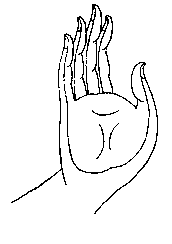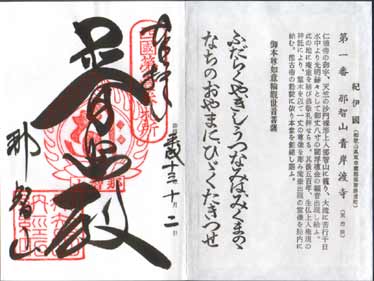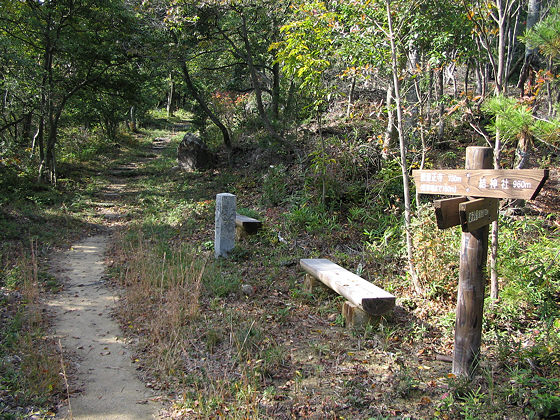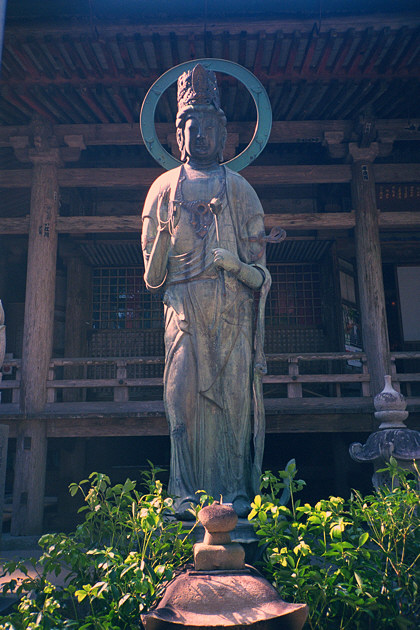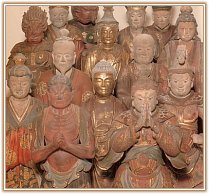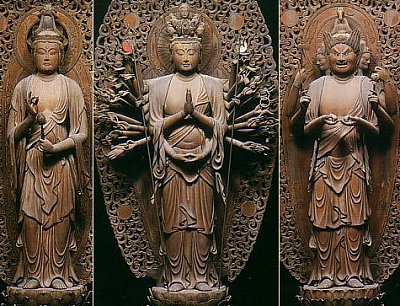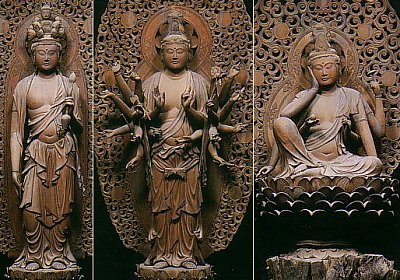Kannon Bodhisattva - Lord of Compassion or Goddess of Mercy
Group Members: John McNiece, Chieh Lun Tang, Chau Nhan, Quang Nguyen, Slava Goncharov

Mantra
On arorikya sowaka (Jpn.)
Om ârolik svâhâ (Skt.)
Om Unstained One svâhâ
Introduction
Kannon is the bodhisattva who embodies compassion. Kannon can either be represented in both male and female forms. The name comes from Avalokitesvara which is translated as “Lord Who Regards All”, though Kannon is literally translated to “watchful listening” and sometimes can be interpreted as “the one who sees/hears all.” Kannon does this by listening to prayers of those in need in the earthly realm and to help them attain enlightenment. In Japan there are many who are considered to be emanations of Kannon. Prince Shotoku Taishi and Daruma are two who are believed to be emanations. The most famous emanation is currently the Dalai Lama who is considered to be an incarnation of Kannon.
An interesting legend involving a manifestation of Kannon named Hatakiri Kannon starts with a young girl who lived at the bottom of Mt. Tokudozan who worked by weaving cloth. The young girl’s father had been banished to a distant island even though he had commited no crimes. Her mother had come to the Mt. Mokudozan to give birth her, though she died without fulfilling her wish of praying properly to Kannon. One day a poor priest comes to hear and asks her for a piece of cloth and with no hesitation she cuts in half the piece of fabric she was working on and gave it to the priest. Due to the girl’s willingness to help the priest carved a statue of Kannon with a piece of cloth over her arm and gave it to her so that she could pray to it every day. This transformed the girl into Kannon, emitting seven layers of light.
Courtesy of YouTube
Mudra
|
Abhaya Mudra |
|
Kannon is often depicted as using the abhaya mudra, especially when he is standing. It is a gesture meant to convey fearlessness. The right hand is raised to shoulder height, the arm is bent, and the palm faces outward. To Western eyes, this might look like he is saying “stop,” but he is actually indicating friendship and peace by demonstrating that his hand is empty of weapons. This mudra, then, symbolizes protection, peace, and the dispelling of fear. The historical Buddha is said to have made this gesture right after attaining nirvana, and later on, when an angry elephant was about to attack him. The abhaya mudra displayed Shakyamuni’s fearlessness and immediately calmed the elephant.
|
Pilgrimage
The Saigoku Kannon Pilgrimage covers 33 temples dedicated to Kannon in Western Japan. It is considered the most famous pilgrimage in Japan. It is believed that Kannon is able to take 33 different forms, which is why there are 33 different temples on this 1500-mile pilgrimage, which extends from Lake Biwata to Kobe, all the way into Japan's east and west coasts.
This particular route dates back to the 11th century, although many of the 33 temples were built much earlier, as far back as the 7th century. Each temple is associated with each of Kannon's miracles, which is why this journey is often called a “miracle pilgrimage.”
Following the tradition, pilgrims visit the temples in order, from 1 to 33.
|
|
Temples |
|
|
1. Seiganto-ji (Seigantoji, Nachi-san) 2. Kimii-dera (Kongoho-ji) 3. Kokawa-dera 4. Makinoo-dera (Sefukuji, Sefuku-ji) 5. Fujii-dera (Gorinji, Gorin-ji) 6. Tsubosaka-dera (Minamihokke-ji) 7. Oka-dera (Okadera, Ryugaiji, Ryugai-ji) 8. Hase-dera 9. Nan'endo (Nanendo) 10. Mimuroto-ji (Mimurotoji) 11. Kami Daigo-ji (Kamidaigoji, Kamidaigo-ji) |
12. Iwama-dera (Shoho-ji) 13. Ishiyama-dera 14. Mii-dera (Miidera, Onjo-ji, Onjoji) 15. Imakumano Kannon-ji (Kannonji) 16. Kiyomizu-dera (Kyoto) 17. Rokuharamitsu-ji (Rokuharamitsuji) 18. Rokkakudo (Shiunzan Chohoji) 19. Kodo (Gyoganji) 20. Yoshimine-dera 21. Anao-ji (Anaoji, Anaoo-ji, Bodai-ji, Bodaiji) 22. Soji-ji (Sojiji) |
23. Katsuo-ji (Katsuoji) 24. Nakayama-dera 25. Kiyomizu-dera (Hyogo) 26. Ichijo-ji (Ichijoji) 27. Engyo-ji (Engyoji, Enkyo-ji, Enkyoji, Shosha-san) 28. Nariai-ji 29. Matsunoo-dera 30. Hogon-ji (Hogonji, Chikubushima) 31. Chomei-ji (Chomeiji) 32. Kannonsho-ji (Kannonshoji) 33. Kegon-ji(Tanigumi-dera) |
Click on the links to find more information and images about these wonderful temples.
The basic procedure at each temple is to have a nokyocho (a book for collecting temple seals) inscribed and stamped at the nokyo (pilgrim's office). This procedure will cost 300 yen. Then, one has to find the hall with the Kannon image, toss some money into the donation box, ring gong three times and say a prayer. One can also light three incense sticks or three candles, the number representing the Buddha, the Dharma and the Sangha.
|
This is an example of a nokyocho entry for the first temple of the Saigoku Kannon pilgrimage. On the left is the temple stamp, name and the date. On the right is a prayer and information about the temple. |
Signpost on the pilgrim's path to Kannonshoji Temple |
Kannon greets pilgrims in front of Seiganto Temple, the first stop on theSaigoku pilgrimage. |
The Rite of Repentance Ceremony
This ceremony, commonly known by the name of Omizutori, is thought to have began in 752 AD by Jitchuu, the chief disciple of Rouben and the founder of the Toudaiji Temple. Due to the Three Poisons: greed, anger, and ignorance, our actions often result in the contamination of our spirits. This disables us from seeing the truth and also makes us ill. Through the Omizutori ceremony, one can repent ones misdeeds and purify mind and body in order to attain well-being. It is interesting to mention that the ceremony originated as a ritual performed on the behalf of the state against natural disasters, epidemics, or rebellions – all were considered as “illness” of the state. In the earlier days, these ceremonies were performed to cure the state of such illnesses, to invite abundant harvests, and to achieve peace and well-being for the people of the state.
Iconography
|
|
Kannon the Bodhisattva has 1000 eyes to see our suffering and has 1000 hands to alleviate our suffering. This specific form was prominent in Japan’s Heian period. it is customary to show the deity with two main arms holding hands in prayer, and 40 other arms holding symbolic objects. The 40 arms each represent 25 worlds, and 40 times 25 equals 1000. Each arm is also said to contain one eye, again totaling 1000 eyes.
|
|
|
She often is shown with the ability to embrace earth and alleviate the suffering of all people in the earthly realm. In Japan, the most widely known pilgrimage circuit devoted to Kannon covers 100 sites.
|
|
|
Thirty-three wood-carved figures were presented to Hase Kannon Temple. They represent the incarnations of the Goddess of Mercy, comes in many forms to save the souls of the suffering.
|
Six Basic Forms of Kannon
Like Japanese groupings of the Six Jizo Bosatsu, the Kannon in Japan is also shown in six basic forms to protect people in all six realms of rebirth (reincarnation).
|
Form |
Realm |
|
1. Aryâvalokitesvara (Shô Kannon) the Sacred Avalokitesvara 2. Ekadasamuhka (Jûichimen Kannon) the Eleven Faced Avalokitesvara 3. Sahasrabhuja (Senju Kannon) the Thousand Armed Avalokitesvara 4. Cintâmanicakra (Nyoirin Kannon) the Wish Fulfilling Avalokitesvara 5. Hayagrîva (Batô Kannon) the Horse Headed Avalokitesvara 6. Cundi (Juntei Kannon) the Mother Goddess Avalokitesvara |
1. Beings in Hell (Naraka-gati in Sanskrit) 2. Asura (Asura-gati in Sanskrit) 3. Hungry Ghosts (Preta-gati in Sanskrit) 4. Deva (Deva-gati in Sanskrit) 5. Animals (Tiryagyoni-gati in Sanskrit) 6. Humans (Manusya-gati in Sanskrit) |
|
From left to right: Shō Kannon, Senju Kannon, Batō Kannon,Jūichimen Kannon, Juntei Kannon, Nyoirin Kannon |
Bibliography
Images
http://www.japanese-antiques.com/marchantprince2002-img450x6.jpg
http://www.buddhist-artofjapan.com/
http://www.coupdefoudre.com/FAQStats/Buddhism/Mudras.html
http://www.mfa.org/collections/search_art.asp?recview=true&id=8380
http://www.taleofgenji.org/images/seiganto_kannon.jpg
http://www.taleofgenji.org/images/kannonshoji_signpost.jpg
http://www.taleofgenji.org/images/saigoku_nokyocho.jpg
jokei-II-montage-six-kannon-sho-senju-bato-daihouonji-TN.JPG
jokei-II-montage-juichimen-juntei-nyoirin-TN.jpg
Text
http://www.onmarkproductions.com/html/kannon.shtml
http://www.buddhist-artwork.com/html/kannon-1000-arms-mini-t.html
http://www.religionfacts.com/buddhism/symbols/mudra_abhaya.htm
http://www.taleofgenji.org/saigoku_pilgrimage.html
http://www.shingon.org/deities/jusanbutsu/kannon.html
Video
http://www.youtube.com/watch?v=Et_onRho2vk
